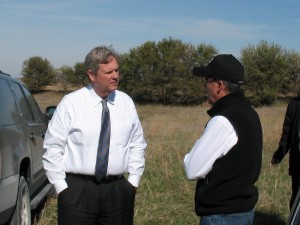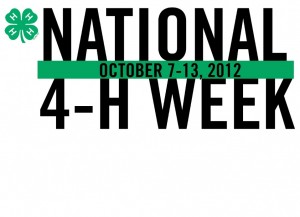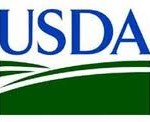CLICK HERE for the latest market quotes from the Iowa Agribusiness Network!
CLICK HERE for the latest market quotes from the Brownfield Ag News Network!
CLICK HERE for the latest market quotes from the Iowa Agribusiness Network!
CLICK HERE for the latest market quotes from the Brownfield Ag News Network!
The first of four drought workshops organized by the U.S. Department of Agriculture was held Tuesday in Omaha. U.S. Ag Secretary Tom Vilsack said this year’s historic drought has highlighted the “resiliency” of American agriculture and the capacity of farmers to embrace new technologies and new techniques.”One of the reasons why we’re potentially going to see yields a little bit higher than we anticipated is because of our farmers acceptance of new seed technologies, in particular, that have allowed yields to be greater than anticipated because the crops are more resilient,” Vilsack said. “At the same time, our farmers have embraced conservation…and perhaps they’ve been able to retain the moisture more effectively than they have in the past.”
Vilsack, a former Iowa governor, said the lack of new Farm Bill will likely delay the federal response to the drought. He added the drought’s impact extends far beyond the family farm. “I think we learned today there are a lot of implications to this drought that you might think of at first. Just as an example, the impact on tourism, the impact on energy supplies, the impact on water resources for our communities,” Vilsack said. “This extends, obviously, beyond the serious impact it has on our producers.” Many workshop attendees agreed the livestock industry faces the biggest challenges in the months ahead – with tight supplies of feed grains and high prices.
Matt Swantek, an Iowa State University Extension swine program specialist, said pork producers are definitely concerned about cash flow. “What’s it going to take to stay in business and be able to…maintain livestock numbers? When this does turn, it’s going to be a turn for the good, which has always been the case in the past,” Swantek said. “But if we don’t have pigs out there to take advantage of it, there’s not going to be an opportunity (to stay in business) long term.” Three more workshops are scheduled to discuss resources available to assist with drought recovery efforts. Those meetings will be held in Pueblo, Colorado; Pine Bluff, Arkansas, and a site to be determined in Ohio.
(Radio Iowa)
U-S Agriculture Secretary Tom Vilsack stood on a portion of a roughly 200-acre plot of land located near the Cass/Pottawattamie County line Monday afternoon, to announce a plan to extend the Conservation Reserve Program, in an effort to continue to conserve and restore wildlife and their habitats, especially the pheasant population.

US Ag Secretary Tom Vilsack speaks with property manager Gary Matters, Monday afternoon, near the Cass/Pottawattamie County line. (Ric Hanson photo)
The move comes in cooperation with Pheasants Forever, the Nature Conservancy, and other, similar groups and is being developed under the SAFE, or State Acres for wildlife Enhancement, Program. In March, Vilsack announced the USDA’s goal of enrolling One-million acres in a new CRP grasslands and wetlands initiative, through continuous signups.
Vilsack said Monday, the USDA is committed to adding 400,000 CRP state acres across the country, with a number of states having additional acres allocated under SAFE. About 20 states he says, will be able to add up to 280-thousand acres for all projects. In Iowa, 50,000 additional acres will be added to SAFE, that are directly related to pheasants’ habitat initiative, to try and increase significantly, the pheasant population. He says in Nebraska, they’ll be adding acres to existing programs, instead of new acres, under SAFE.
That includes 74-hundred acres to the Prairie Chicken effort, which will add to the 21-thousand acres currently enrolled in the program in eastern Nebraska, and another 22-thousand acres will be added to the 31-thousand allocated acres for the Upland Bird Habitat Initiative. SAFE is currently capped at 1.25-million acres, nationally. Acres are allocated across 97 SAFE projects in 36 states and Puerto Rico. The Ag Secretary said sign-up for the additional CRP acreages won’t be possible, however, until after Congress, and more specifically, House of Representatives, has finished its work on the Farm Bill.
He says by connecting and educating people about the “economic driver” that conservation and outdoor recreation is, officials hope once Congress returns after the election, that they finish the work they started. Vilsack was asked if it was “Fair,” to hold a press conference in a swing state like Iowa, less than a month before the election, in a contested location for the Iowa House of Representatives. Vilsack was also asked if this was a role for the USDA, or an attempt to sway voters. He said Iowa is number one in the country in filter strips, number one in grassland reserve areas, and one of the leading conservation and CRP states, as well as wetland reserve states. Therefore, he said, it is “Appropriate and necessary, at the beginning of hunting season, to talk about habitat, to educate people about the link between habitat and conservation, and economic development and jobs.
Vilsack his stop was all about the SAFE Program, something he’s been working on all year long, and for the past four-years. He said in Iowa, about $3-billion dollars worth of sales and economic activity is associated with conservation and outdoor recreation. He says that generates $700-million for state and local governments, and helps to employ nearly 31-thousand people. The land Vilsack spoke on Monday, is managed by Gary Matters, of Council Bluffs. It’s owned by his father, Fred Matters, who is retired, and lives in Urbandale.
October 7th through the 13th is National 4-H Week. Cass County is celebrating the 4-H youth who have made an impact on the community, and are stepping up to the challenges of a complex and changing world. On Wednesday, October 10th, from 2:30 to 5:30 p.m., 4-H youth along with their family, friends and extension staff will host a 4-H Open House for anyone in the community, at the Cass County Community Center.
Cass County is celebrating the 4-H youth who have made an impact on the community, and are stepping up to the challenges of a complex and changing world. On Wednesday, October 10th, from 2:30 to 5:30 p.m., 4-H youth along with their family, friends and extension staff will host a 4-H Open House for anyone in the community, at the Cass County Community Center.
The planned activities will allow 4-H members and staff to showcase some of their project areas with hands-on activities designed to encourage new membership. County Youth Coordinator (CYC) Susan Oliver says the events will include participation areas where anyone interested in 4-H can experience firsthand what it might be like to become a 4-H member. Cookie decorating, hands-on science projects, craft areas as well as the “Clover Corner” for younger siblings are just a few of the events planned for the afternoon. If you have ever considered joining 4-H, if you are a 4-H member, or you would just like to know more about the program we encourage you to stop by the open house.
Also during National 4-H Week, hundreds of thousands of youth from all around the nation will complete a single, innovative experiment on 4-H National Youth Science Day, which is on Wednesday, Oct. 10, 2012. Here in Cass County you can come work first hand on science with our Regional Youth Specialist Jane Hayes-Johnk.
In Cass County, approximately 250 4-H members and 115 volunteers are involved in 4‑H. To learn more about how you can be a part of 4-H as a member or a volunteer, please contact Susan Oliver, CYC, at Iowa State University Extension and Outreach Cass County, at 712-243-1132 or smmck@iastate.edu .
The National Weather Service in Omaha has extended the Red Flag Warning to cover Harrison, Shelby and Pottawattamie Counties in southwest Iowa. The warning is in effect until 6-p.m. Previously, the warning covered those counties along and north of Highway 30. In addition, the Grassland Fire Danger Index will be in the EXTREME category today for the counties mentioned.
Officials say low humidity, winds gusting out of the southwest from 15-to 30-miles per hour will combine to create explosive fire growth if a fire should develop. Fires are especially possible in extremely dry fields and grassy areas. Outdoor burning is not recommended, and most counties in the area have a burn ban in place.
A Red Flag Warning mean that critical fire weather conditions are occurring or will shortly.
While Iowa’s an agricultural state, some Iowans have lived their whole lives and never set foot on a farm. A program through the group “Farmers Feed US” invites all Iowans to learn more about the origins of their food along with the chance to win 12 months of free groceries. Justin Dammann, who farms near Essex in southwest Iowa, is one of eight featured Iowa farmers on a website that showcases their operations. “Listen to the video, see our farm and how we grow corn, soybeans and cattle and then answer the trivia question and register to win free groceries for a year,” Dammann says.
Everyone should know more about how the food they eat is produced, he says, in addition to how livestock are cared and how farmers work to protect the soil, air and water. The website features beef cattle, dairy cattle, turkey, corn, hog and soybean farmers from across the state. “We promote those products voluntarily through programs like the Farm Bureau or Farmers Feed US and tell our story, how we produce them and show America and the world,” he says. “If we didn’t think those products were safe, we certainly wouldn’t be feeding what we grow to our own children.” Among his crops, Dammann raises white corn, which is for human consumption. “None of that goes into the cattle market or the livestock market,” he says. “It’s kind of neat to see how the white corn is raised here in Iowa and is turned into white flour and then is used to make tortillas and tortilla chips. It’s neat to see that farmer’s gate-to-the-plate movement.”
The website offers an up-close look at eight Iowa farm families and a chance to tour their farms, in addition to the two grand prizes of free groceries for a year. The other farmers featured are: Russ Yoder, turkey farmer, Wayland; Eric and Emily Crossman, hog farmers, Ogden; Jim Brown, soybean farmer, Churdan; Pam Johnson, corn farmer, Floyd; Stephanie Dykshorn, dairy cattle farmer, Ireton; Matt Schuiteman, hog farmer, Sioux Center; and Tim Kaldenberg, beef cattle farmer, Albia. Learn more at the website: www.FarmersFeedUS.org/ia
(Radio Iowa)
Counties: MONONA-HARRISON-SHELBY-POTTAWATTAMIE–
THE GRASSLAND FIRE DANGER INDEX WILL BE IN THE EXTREME CATEGORY THIS AFTERNOON. EXTREME FIRE DANGER MEANS THAT FIRES START QUICKLY…SPREAD FURIOUSLY AND BURN INTENSELY. ALL FIRES ARE POTENTIALLY SERIOUS. ALL OUTDOOR BURNING SHOULD BE AVOIDED IN AREAS WITH EXTREME FIRE DANGER.
Counties in Western Iowa: SAC-CRAWFORD-CARROLL-GREENE//Mon., Oct. 8th 2012
RED FLAG WARNING IN EFFECT FROM NOON TODAY TO 7 PM CDT THIS EVENING FOR EXTREME FIRE CONDITIONS.
THE MOST HAZARDOUS CONDITIONS ARE EXPECTED FROM AROUND MIDDAY THROUGH THE AFTERNOON HOURS UNTIL A LITTLE AFTER SUNSET. WINDS OF AROUND 25 MPH ARE EXPECTED AT TIMES…WITH GUSTS IN EXCESS OF 35 MPH IN THE AFTERNOON. THE RELATIVE HUMIDITY WILL BE AS LOW AS 20 PERCENT IN THE AREA. IN ADDITION, SURFACE FUELS ARE VERY DRY DUE TO DROUGHT CONDITIONS AND PERSISTENT LACK OF RAINFALL.
ANY FIRES WILL SPREAD RAPIDLY. BURNING OF ANY KIND SHOULD BE POSTPONED…AND HARVESTING OPERATIONS SHOULD EXERCISE A HIGH LEVEL OF CAUTION. PRECAUTIONARY/PREPAREDNESS ACTIONS… A RED FLAG WARNING MEANS THAT CRITICAL FIRE WEATHER CONDITIONS ARE EITHER OCCURRING NOW…OR WILL SHORTLY. A COMBINATION OF STRONG WINDS…LOW RELATIVE HUMIDITY…AND WARM TEMPERATURES WILL CREATE EXPLOSIVE FIRE GROWTH POTENTIAL.
The National Weather Service in Des Moines, says there will be an increased Fire Danger risk across the northwestern two-thirds of Iowa Monday afternoon. Locally, counties included in the Elevated Fire Danger advisory are: Crawford, Carroll, Audubon, Guthrie, Dallas, Cass, Adair, Madison, Adams, Union, Taylor and Ringgold.
Much warmer temperatures are expected by mid-afternoon, Monday. Along with warm readings, dry relative humidity of 20-to 25%, and winds at 20-to 25-mph with higher gusts, may push fire conditions to near critical levels for several hours, Monday afternoon. With harvesting occurring in many areas, caution is advised, due to the increased potential for fires to spread rapidly.
Monitor later forecasts and statements for possible Fire Weather Watches or Warnings.
The lineup of activities is set for Harvest Fest in Atlantic on Saturday, October 13th and there will be plenty of activities for the entire family to enjoy.
Crafters will be open from 10 a.m. to 4 p.m. as well as the quilt show sponsored in part by Atlantic Locker, Rex Pharmacy and Something for you.
Free downtown tractor rides will start at the Depot and ride to City Park and back from 10 a.m. to 4 p.m. Music can be enjoyed with an acoustic performance of Dirt Road Acoustic Rehab, a country and blues sounding local band, from 11 a.m. to 1 p.m. presented by McDermott and Son Roofing and Tanner’s Fashions. The band will also be performing in full on Friday night during the Rib Fest activities.
Apple pies must be entered by 2 p.m. Saturday at the Depot for the Gade Insurance & Farmer’s Kitchen Contest and the Children’s Pumpkin Painting with McCurdy Pumpkins will be at 3 p.m.
Atlantic Chamber Director Megan Roberts said “The pumpkins typically go fast, so we encourage everyone to show up early. While families are there waiting, they can enjoy tractor rides, lunch, crafters or the entertainment. There is something for the whole family at this fall festival.”
The U-S Department of Agriculture says Agriculture Secretary Tom Vilsack will be near Lewis Monday, to announce the allocation of additional conservation acres for 20 states, including Iowa, under programs to preserve grasslands and wetlands and accelerate protection of critical species and habitat around the country.
will be near Lewis Monday, to announce the allocation of additional conservation acres for 20 states, including Iowa, under programs to preserve grasslands and wetlands and accelerate protection of critical species and habitat around the country.
Vilsack will speak near the Zimmerman Farm located three-quarters of a mile east of the intersection of 525th Street and Idelwood Road, at 3-p.m., Monday.
The allocation includes new acres in Iowa to preserve Pheasant habitat, restore Iowa’s Pheasant population, and ultimately generate economic benefits across Iowa through increased outdoor recreation and hunting. The Secretary will also highlight the importance of passing comprehensive, multi-year food, farm and jobs legislation, which officials say will provide America’s rural communities with the certainty that millions of acres of conservation lands will be there in the future to sustain and create jobs in the small businesses that reinforce the nation’s tourism and recreation industry.
Additional details are currently pending.